Written by Michael Auliso and republished here with his permission.
Missing all images on page 2
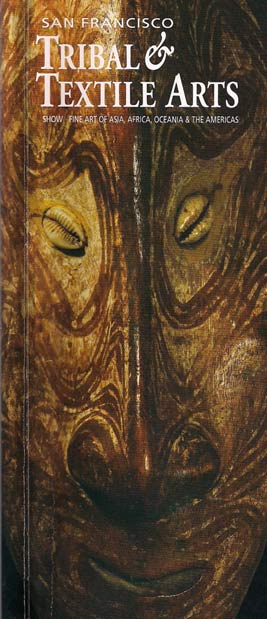
The show looked very attractive as always, but in a perfect world would be scheduled for a dryer month like April for example… February is historically the wettest month for the Bay Area which I feel affects attendance most years. You practically need to be a diehard art lover to journey to San Francisco’s Fort Mason during rain storms. The exhibitors must set up and break down their exhibits in the rain as well, which can make the experience less than pleasant.
As a general rule many of the tribal dealer’s booths are located in the front half of the venue. As you strolled past the food court however, the show became disjointed and an mishmash of dealers selling other-than-tribal-items, which I don’t cover here. Tribal dealers that are still located in the back should try to reposition themselves forward, in my opinion.
Regarding the status of the current “market” climate, you can read my previous reviews which discuss that at length. Little has changed economically so there is no point in being redundant here.
links to 3 previous reviews:
- 2011 February The San Francisco Tribal & Textile Arts Show
- 2012 February The San Francisco Tribal & Textile Arts Show
- 2013 February The San Francisco Tribal & Textile Arts Show
The venue lost a few more key dealers this year including Dalton Somare’ (Milan Italy), Joris Visser (Brussels), Marcuson & Hall (Brussels), Kevin Conru (Brussels), and Christopher Selser (Santa Fe- NM). There were no French dealers exhibiting this year. Gallery Flak in Paris was last to leave the show two years ago.
The composition of dealers pretty much mirrored the “market” at that moment in time in San Francisco. When there was a stronger market (not too long ago), we would correspondingly see more top dealers entering the show with strong material. It may be that the show cannot afford to lose anymore European dealers and still maintain its perception of quality. In the past European dealers would buy from American and other dealers, which was positive. With the quality they often bring, they satisfy many a collector’s appetite for great material. As it stands the European dealers may need to be lured back by the promoters. The euro is high creating a disincentive to sell in dollars and the show costs them around $10K or more (Booth, airfare, hotel).
I personally noted or was told that staff from every auction house in the States were there except Sotheby’s. Also in attendance were local museum curators as well as others from around the country.
Many dealers who have exhibited here a decade or more, said they would be satisfied if they sold half or even a third of the sales they had prior to 2008. From the “sales aspect” there is a rotation of success and pain at this show. One year might be good and the next bad. It is never consistently good, unless you have very loyal adoring customers (two dealers -only- come to mind). From what I could tell, the dealers who have stuck in there year in and year out are now being rewarding with business, since many of the familiar names and key players are out. In terms of high value sales I only heard of one. I could be wrong but I feel their were few sales over the $25K range.
The opening night, hosted by the De Young, is an impressive shindig but seldom translates to sales for most dealers. Dealers get frustrated watching people hardly leave the food court. Who can blame them for $150 ticket though. For most people that attend, it is not about art but about schmoozing, food and drink which is damn good, btw. In my view it is all about sales for the dealers however. I think the best way to boost sales for them would be to diminish or eliminate the lavish Thursday opening event and open the show to everyone on Friday morning for $10. There would be much more excitement, pent up demand, lines to get in, and yes even competition between customers which directly benefits the exhibitors.
Keeping it positive I really enjoy “shopping” at the show instead of covering it. There were some great quality things there for reasonable prices. Some of the astute non-exhibiting French dealers were making purchases and enjoying the strength of the Euro, but not many.
Okay, lets check out some photos. Note: these images only represent a small sampling of dealers and pieces found at the show. I’m just serving you a “spoon” from the soup bowl.
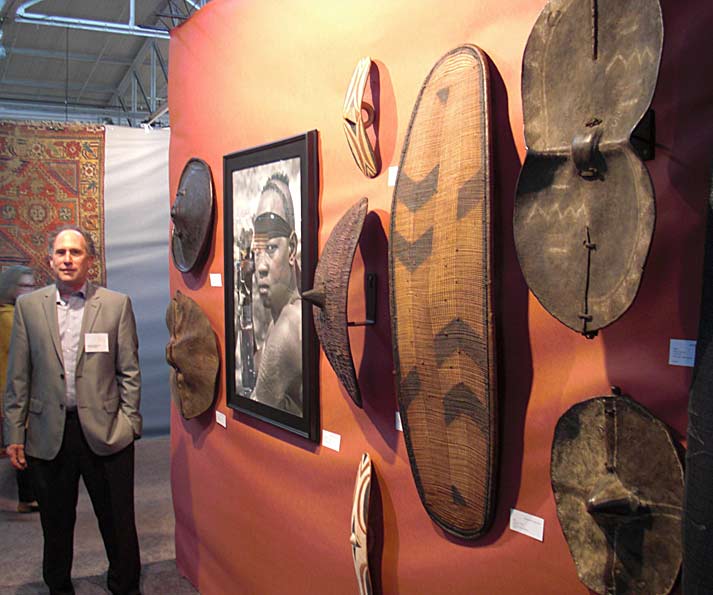
Joshua Dimondstein with a nice selection of shields on his outside wall
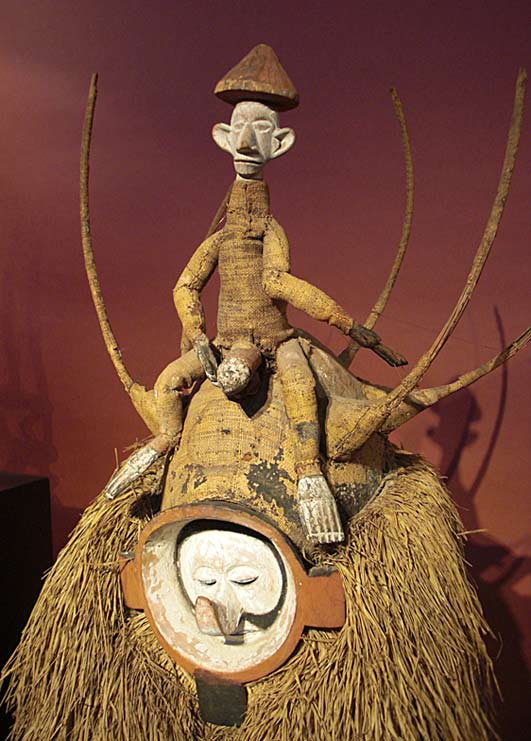
Dimondstein Tribal Art: Yaka Initiation mask, Published: “African Art in American Collections”
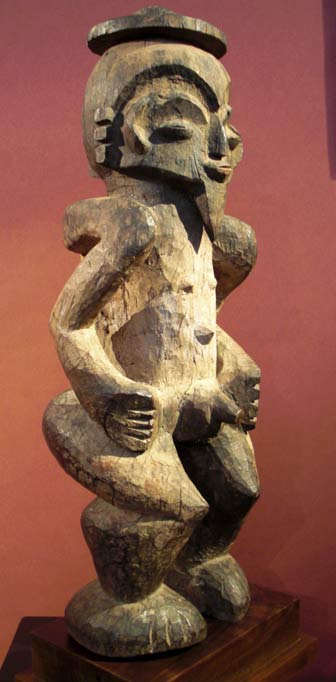
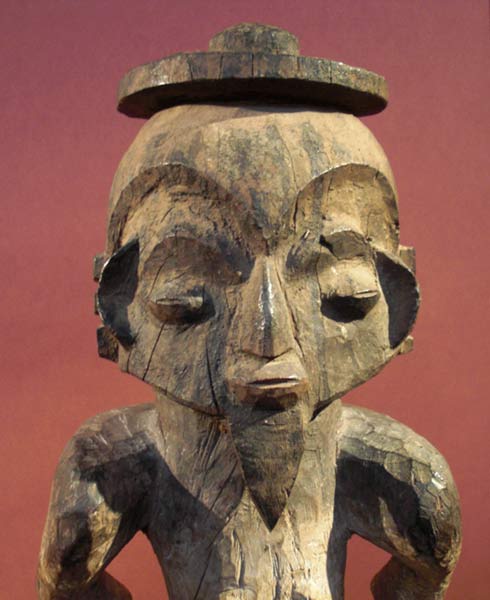
Dimondstein with a male figure from Eastern Nigeria (Cross River) Mbembe
th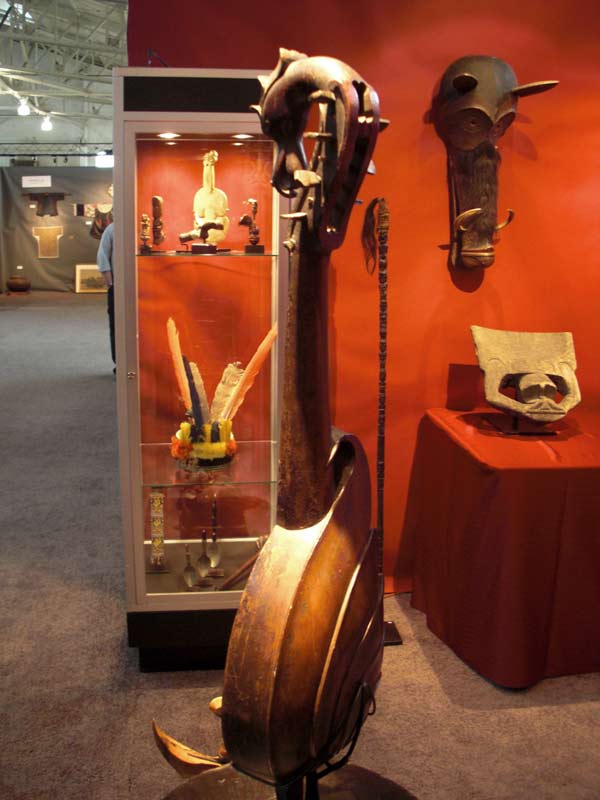
Sutterfield Tribal Art with a 19th C. Southeast Asian Lute/ guitair (Illustrated in the show catalog)
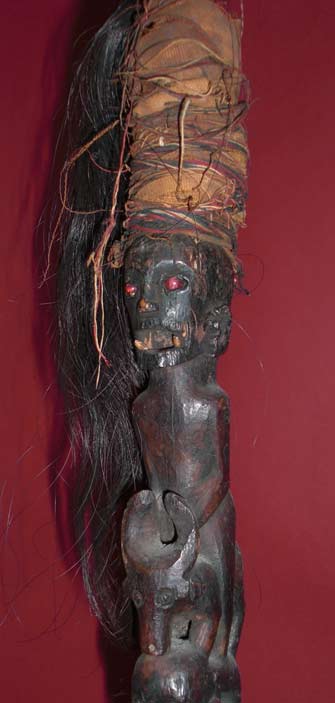
Sutterfield Tribal Art with an expressive Batak “Datu’s” staff from Sumatra
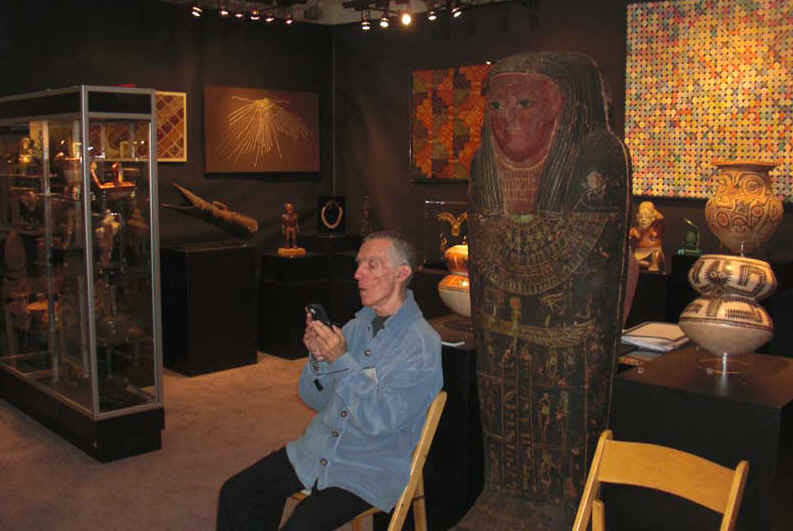
Leonard Kalina and Jerry Boch
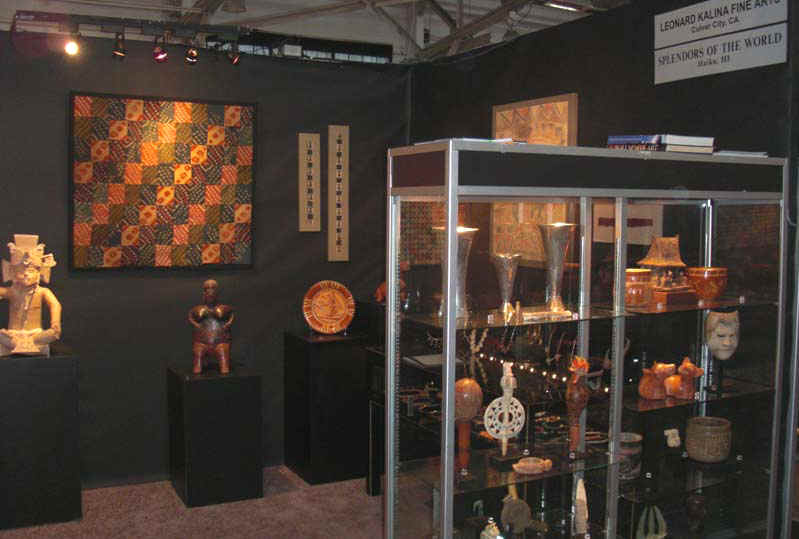
Leonard Kalina and Jerry Boch
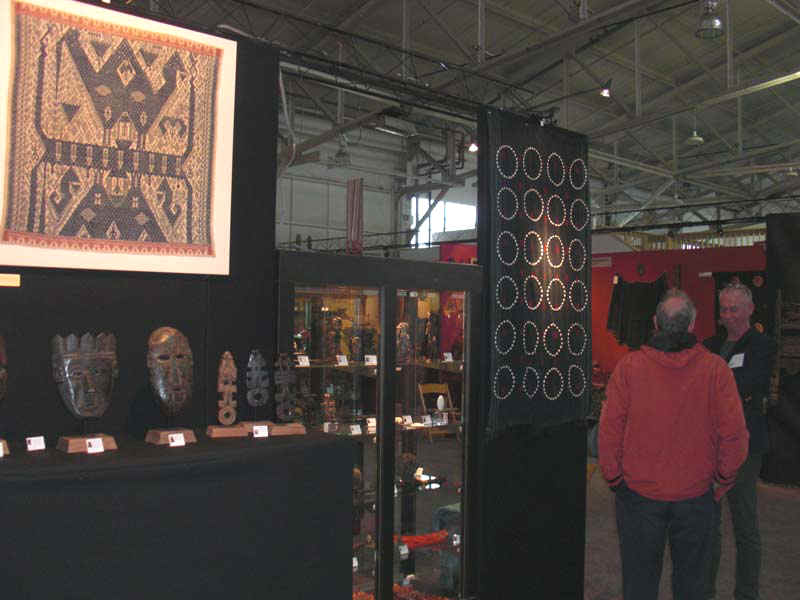
Louis Nierijnck/ Karavanseri (Maastricht)
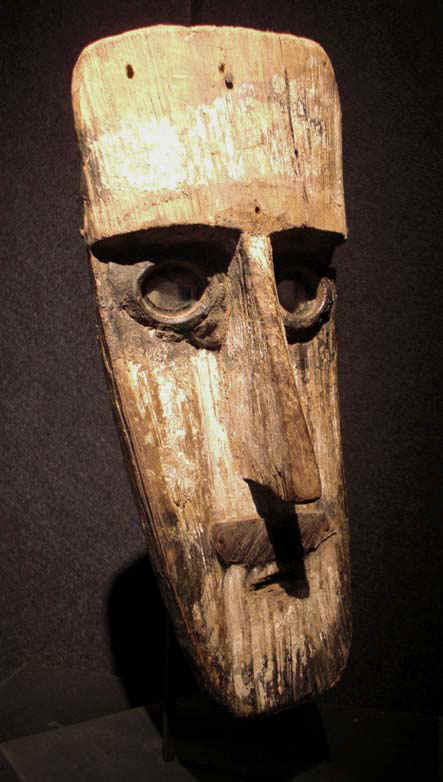
Louis Nierijnck/ Karavanseri (Maastricht)
Indonesian Flores Mask, Old Dutch collection
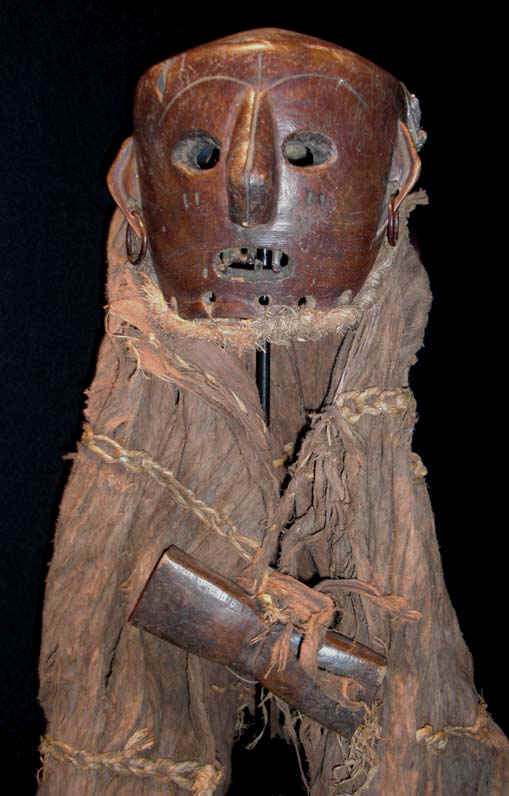
Bryan Revees/ Tribal Gatherings London with a Sukuma mask costume, Tanzania. Ex. Walter Hekster collection- published
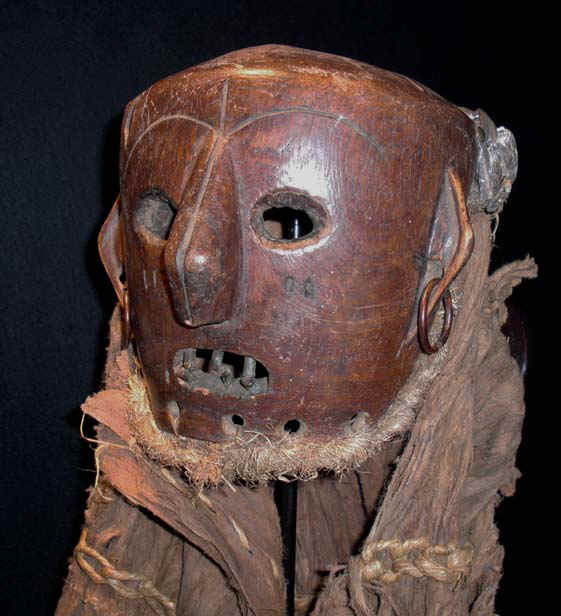
Detail of above
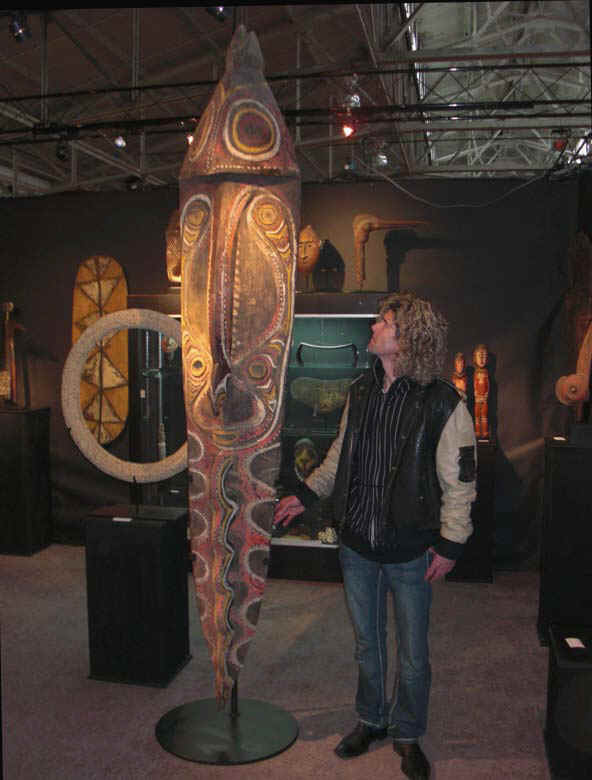
Booth of Chris Boylan Sydney. Me standing next to a large New Guinea Upper Sepik Washkuk Yena figure
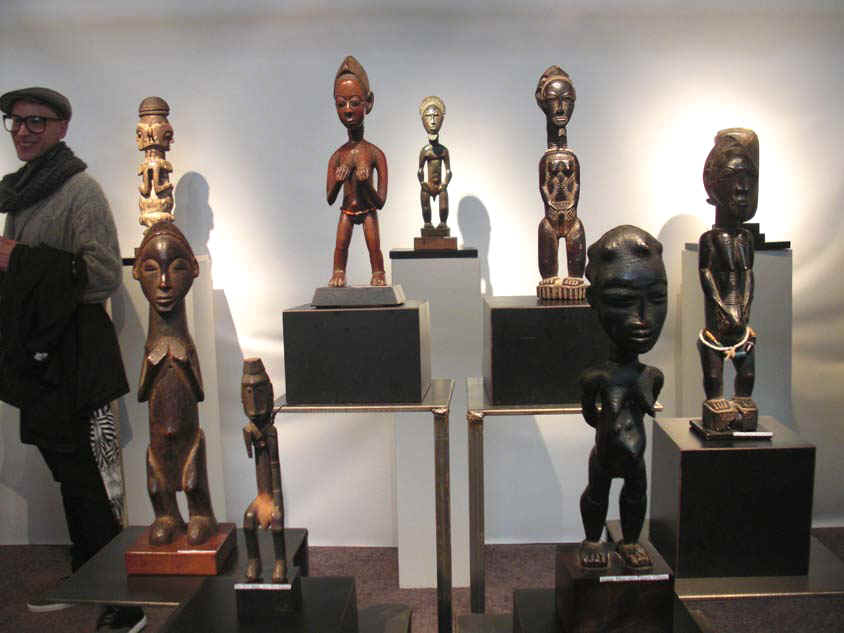
James Willis
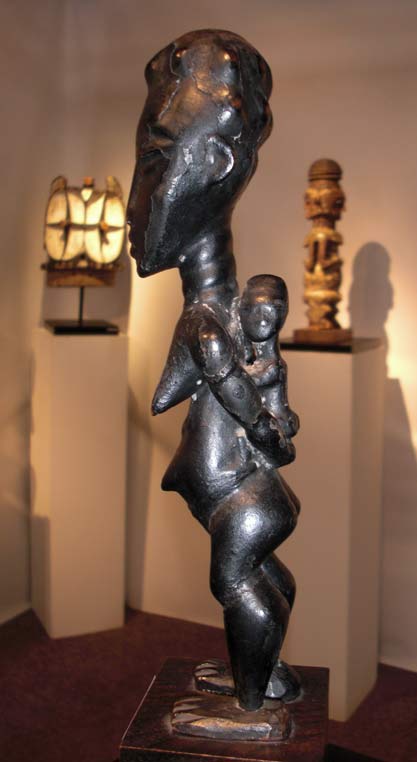
James Willis with an Akan maternity figure from the Ivory Coast
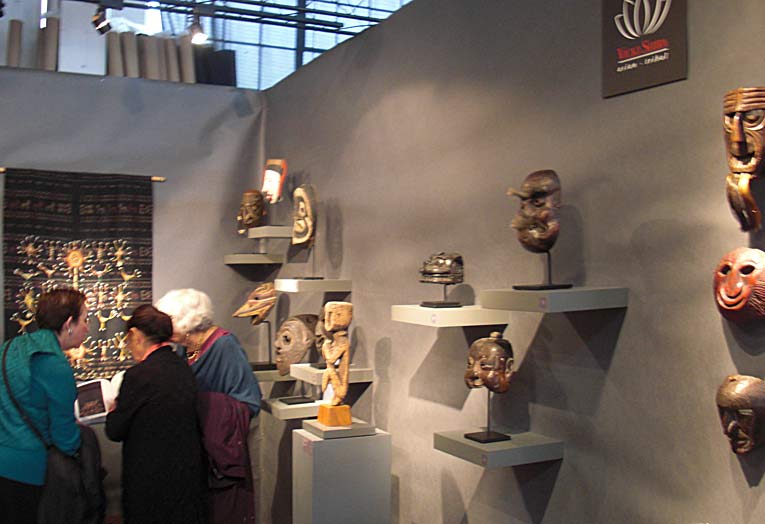
Vicki Shiba (opening night) discussing an Indonesian ritual Sarong from the Ngada people of Central Flores. A wide selection of masks too.
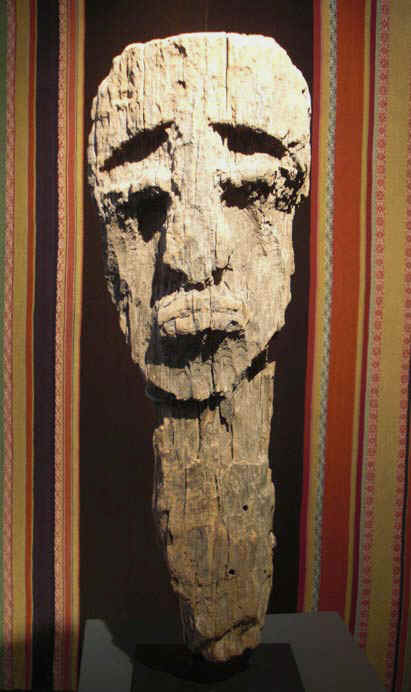
Vicki Shiba. 19th C. Ojibwa Indian sacred post marker.
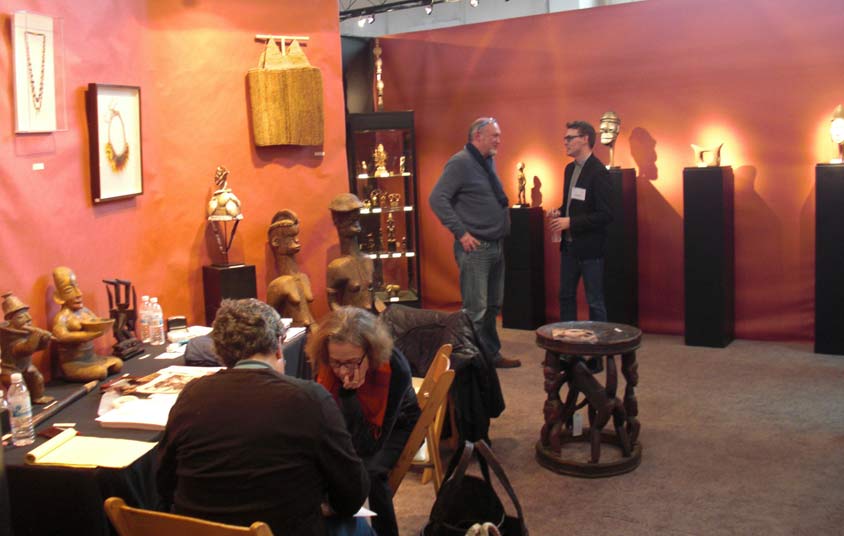
Dave DeRoche and Jo De Buck’s booth in the front entrance. Jo De Buck and Cole and Harrell in the background.
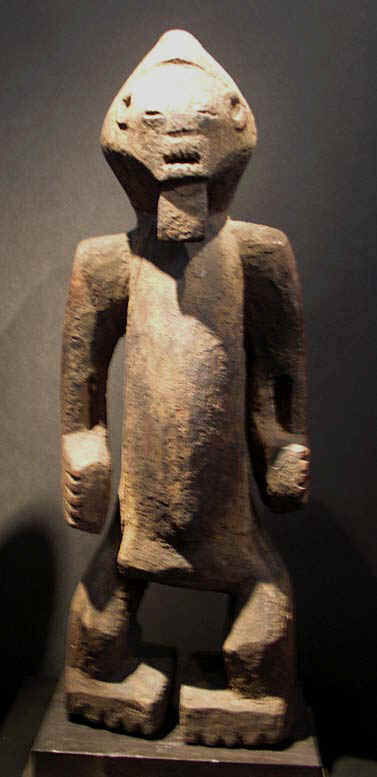
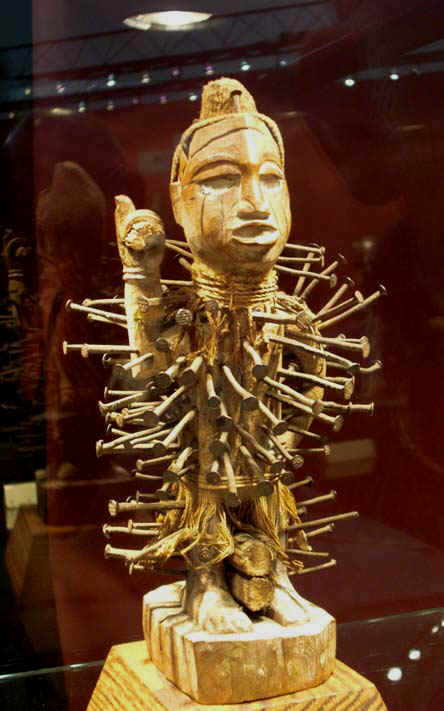
(Jo De Buck ) a pretty great “Keaka” figure (left) from Nigeria with long provenance and exhibition history. (Right) A Congo nail fetish.

DeRoche, with a couple Sepik maskettes
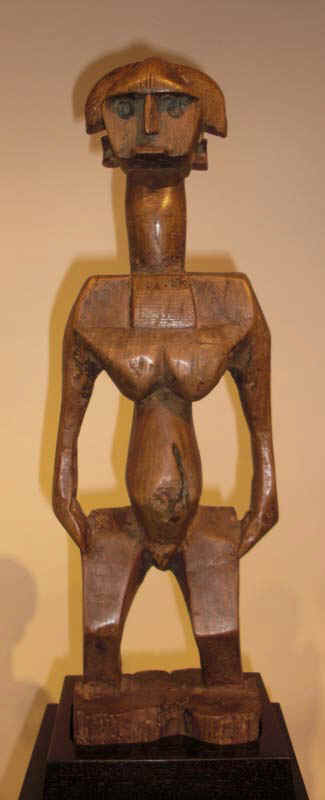
Peter Boyd- Seattle
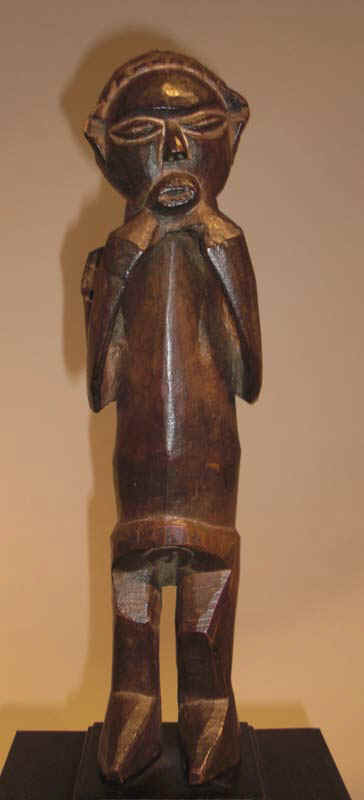
Peter Boyd with an Angolan figure
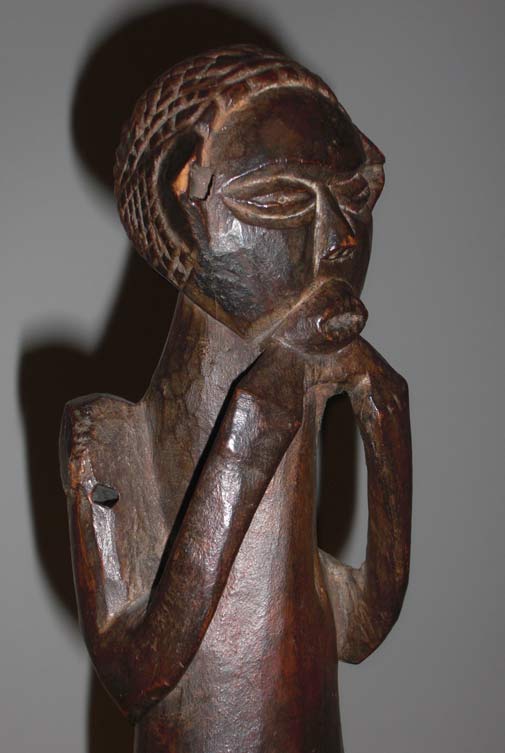
Peter Boyd (detail)
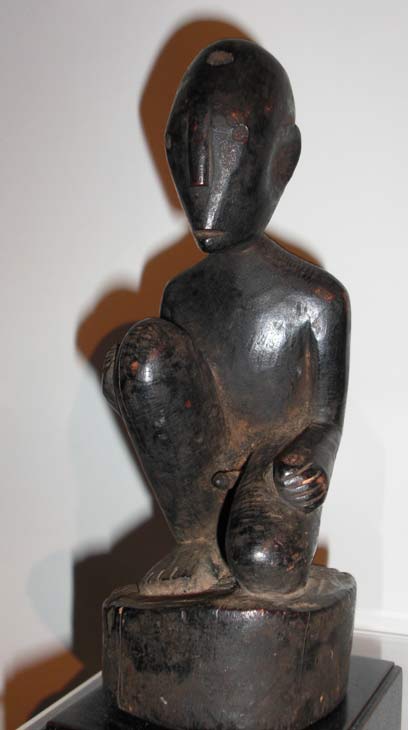
Peter Boyd, A unique Makonde figure Tanzania
Foyer Exhibit:
“Transformation Masks and Artistic Metamorphosis”
Artist: Mort Golub
Curator: Thomas Murray Producer: Elizabeth Lees
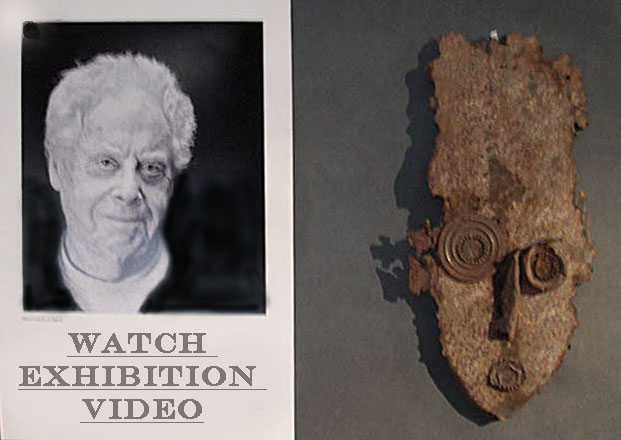
Exhibition Photos:
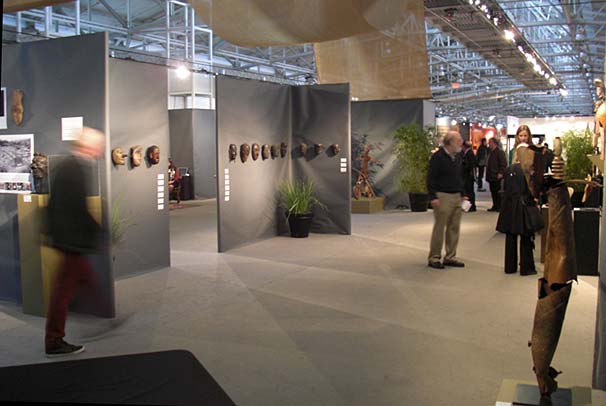
My favorite part of the show was the exhibit in the foyer consisting of Bay Area Artist Mort Golub’s contemporary mask creations which were inspired by masks from the Himalayas and Indonesia. I really like much of what he is creating. Every piece has a soul, even the most abstract masks! I hope this is the jumping off point for Mort into deserved “branding” by the art community…. Next to the shield exhibit (years ago), it was the best exhibit in the foyer I can remember. The Himalayan masks were owned by Thomas Murray the curator.
Some felt it could have been a more inclusive exhibit where masks were culled from various dealers. Tom told me he originally proposed that Idea to Elizabeth Lees but she understandably nixed this option because it added an insurmountable level of complexity or an already challenging exhibit.
To be honest I blew past most of these foyer exhibitions past in years, but I kept coming back to this one. After seeing a body of Mort Golub’s art again, I really got just “how” inspired he is. Wow! I found the exhibit to be a rich art experience. Mort has been represented continuously by Cavin Morris Galley for 10 years. I wish them much more success going forward.
“Through an internal creative alchemy he would transform these discarded shards of our consumer society into compelling visionary art. And as his body of work grew, it became clear that something very special was happening: Mort had gone from collecting art to making it”. And the art he was making was not only good, it was truly inspired!
I think the exhibit achieved its goal of “telling the artist’s story while introducing his art to a whole new audience which may be unfamiliar with Mort Golub or the masks from various lands that inspired him.” Taken from the San Francisco show catalog article: “Transformation Masks and Artistic Metamorphosis” by Thomas Murray. I recommend getting a copy from the promoters.
Exhibition Photos:
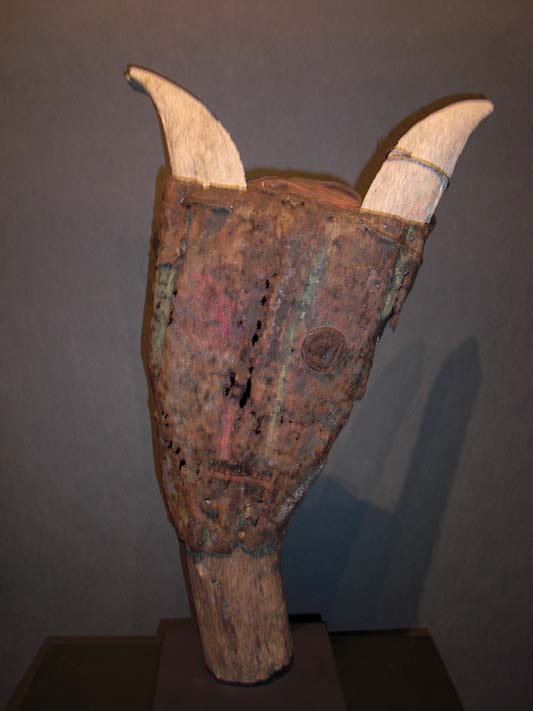
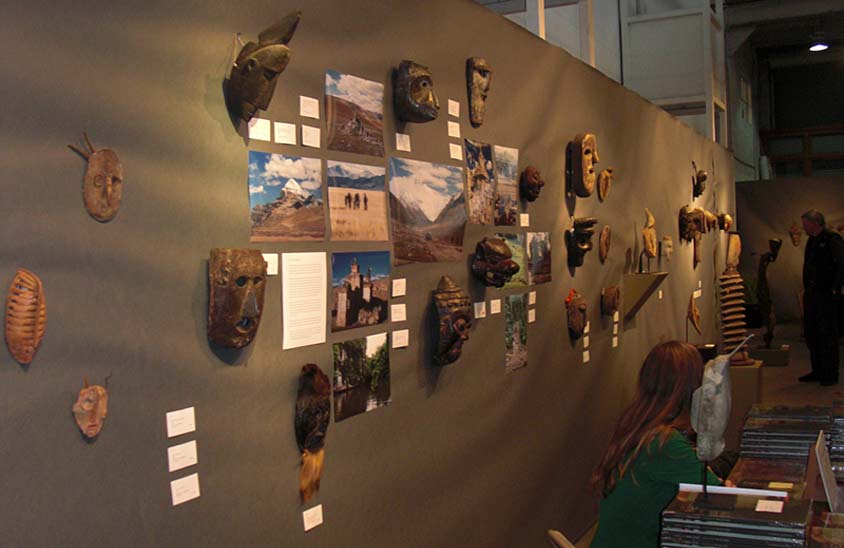
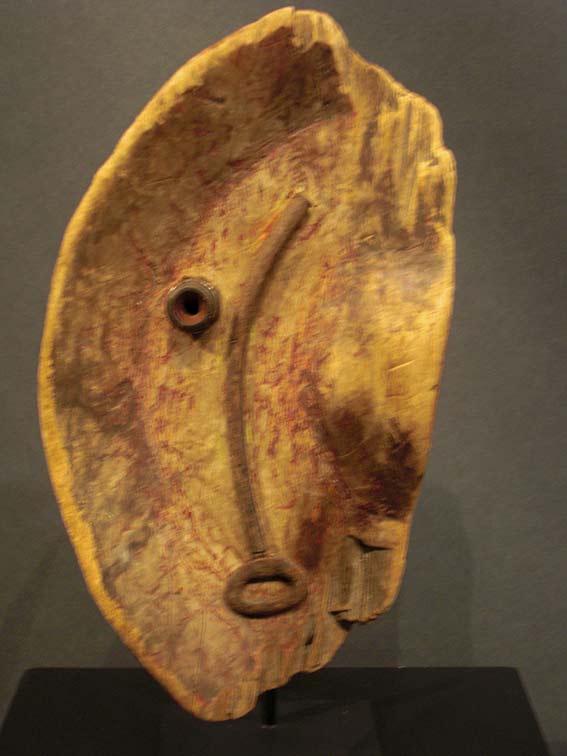
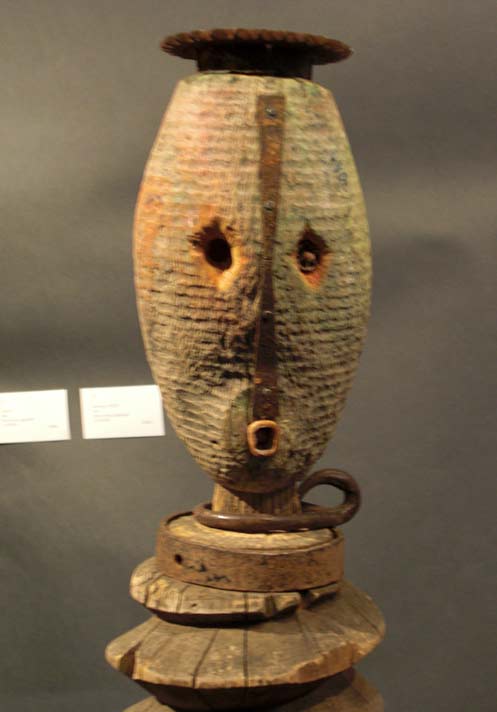
Exhibition Photos:
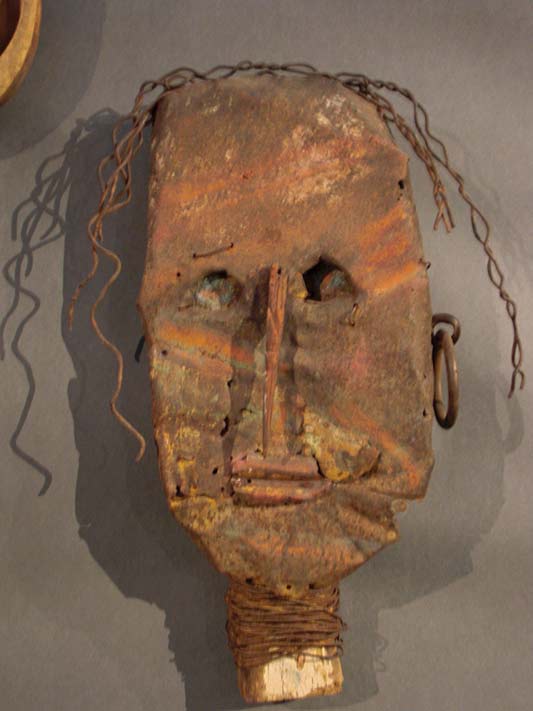
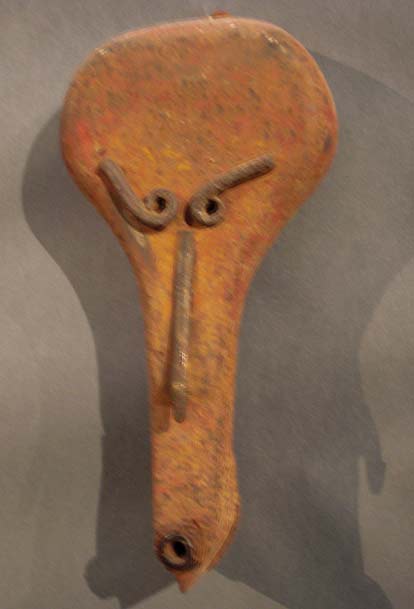
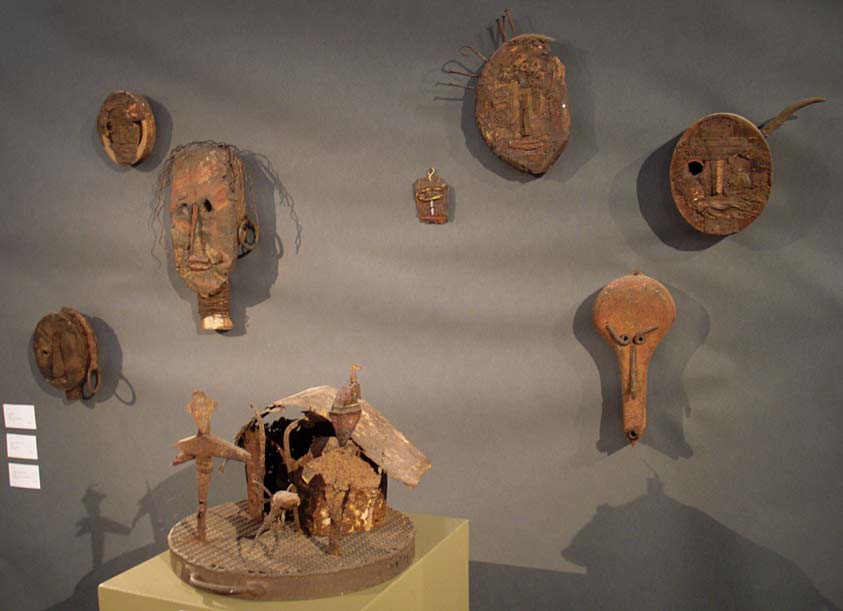
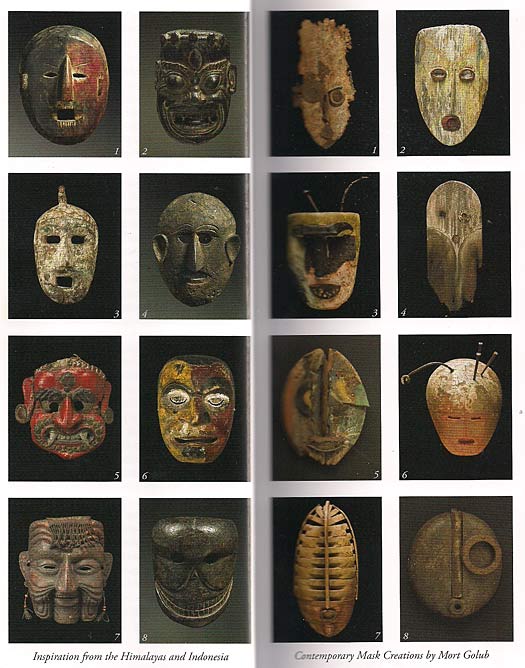
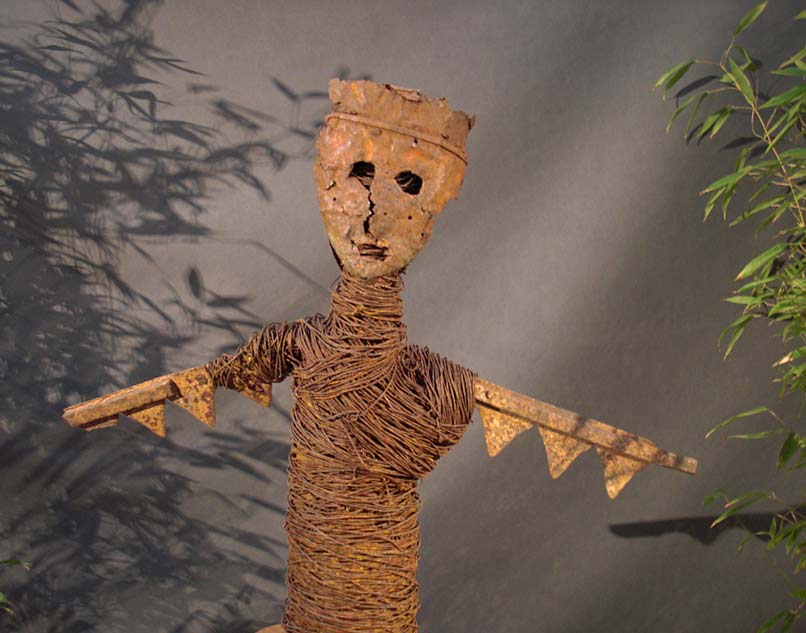
Exhibition Photos:
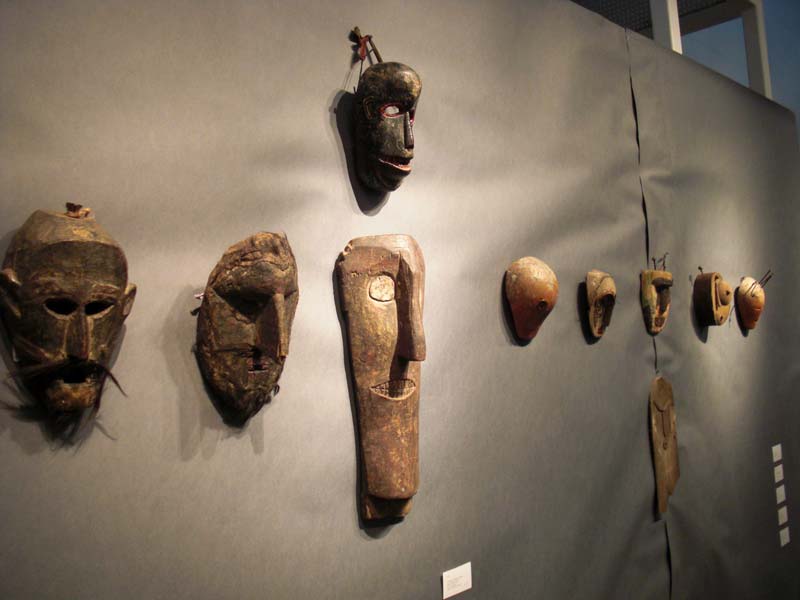
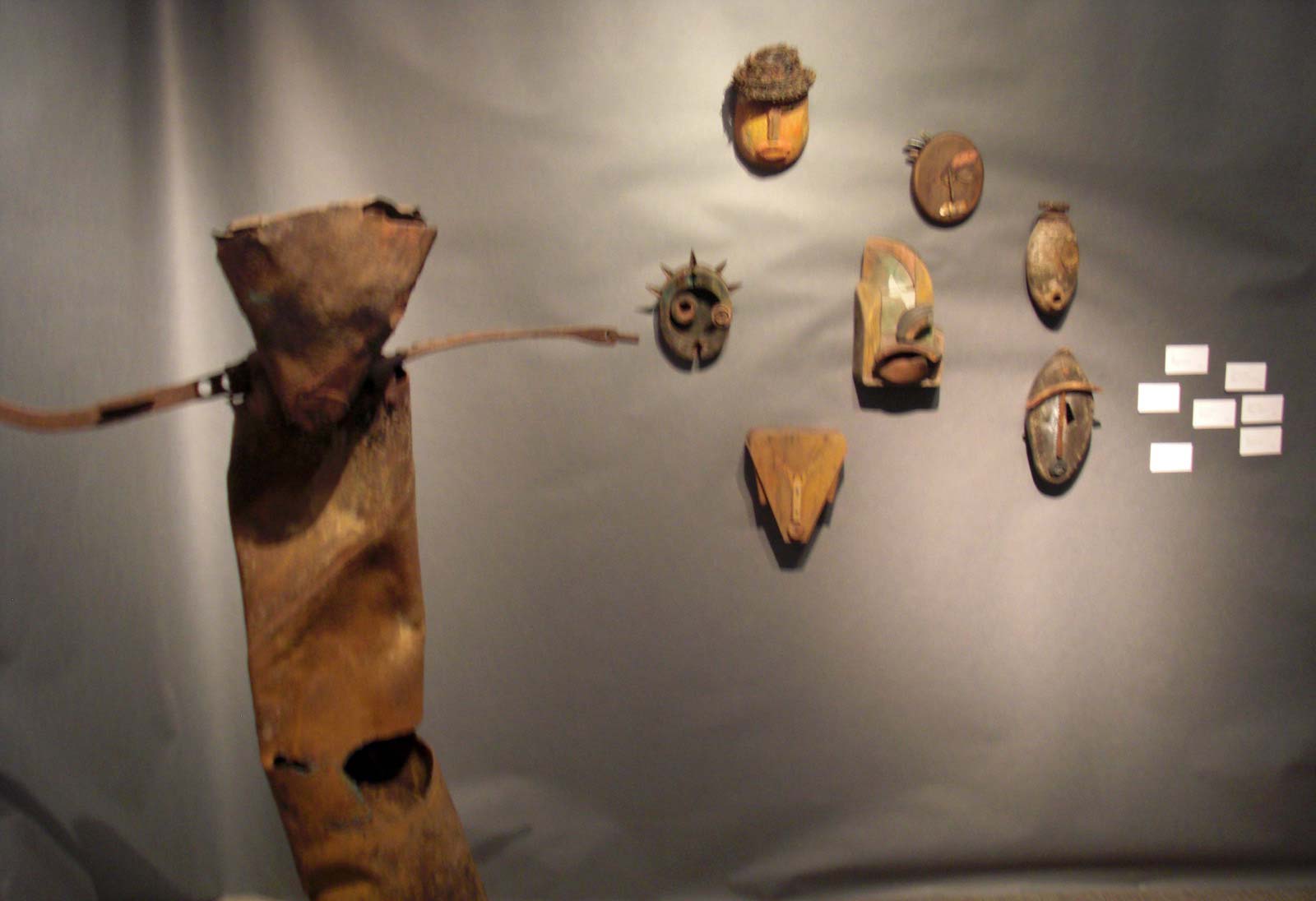
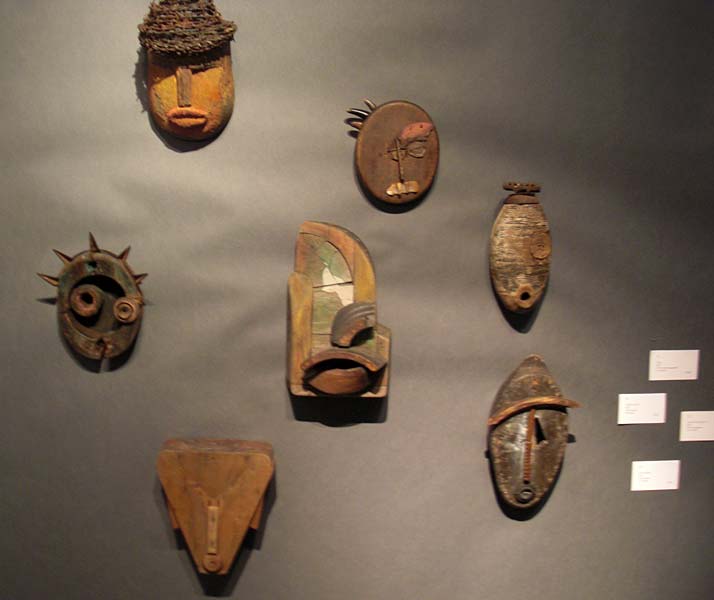
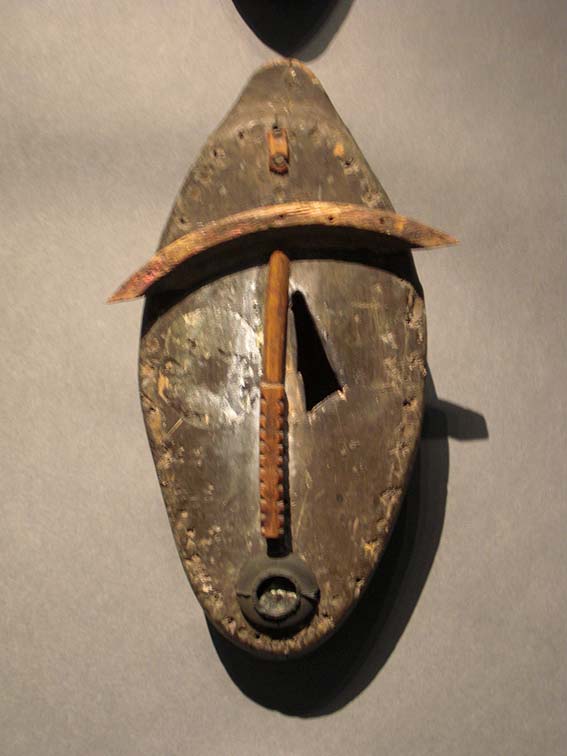
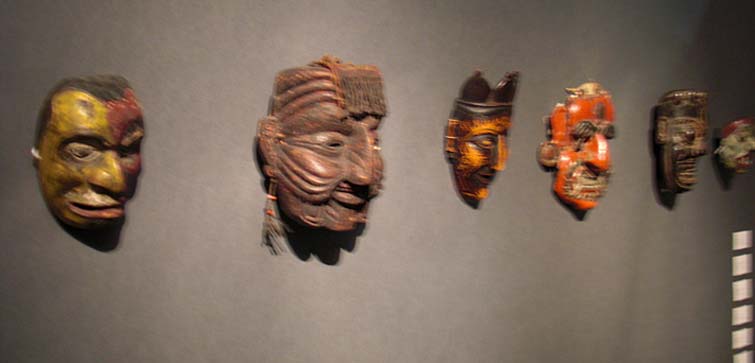
Exhibition Photos:

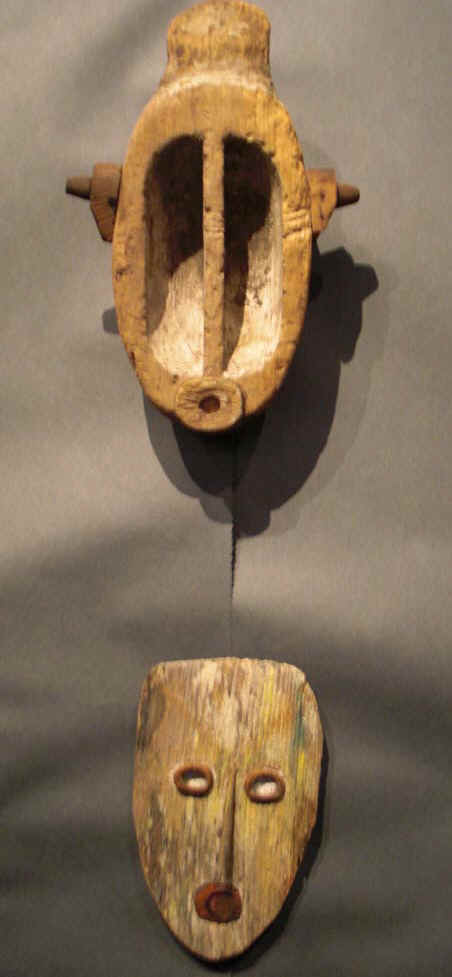
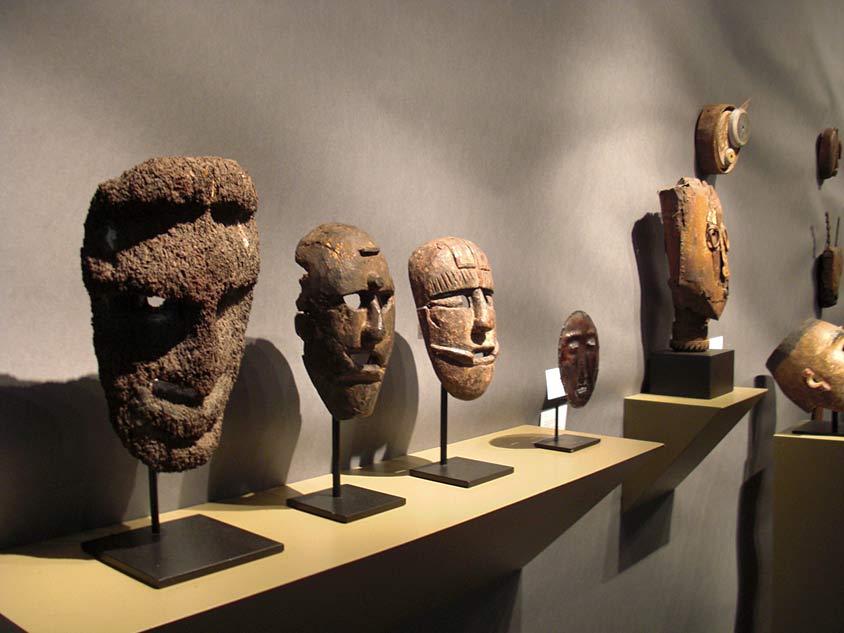
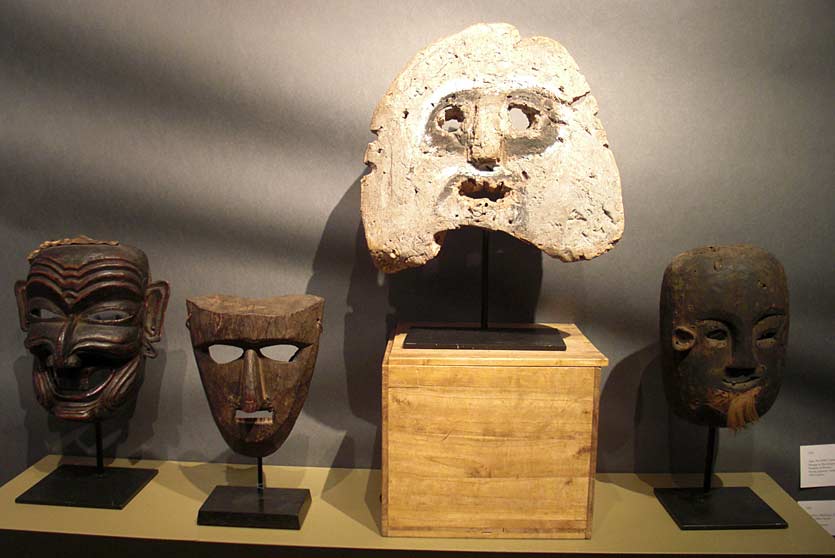
(END) Exhibition Photos
Watch exhibition video below
For better photos check out Mort Golub or Thomas Murray’s Website.
In the future it would be a great idea to use this foyer exhibit space for outreach and education to appeal to new collectors, as I felt this exhibit did. Other tailored exhibits and maybe some lectures could go a long way in helping to broaden the market and build collectors. The new buyers, I’m occasionally meeting, do not collector tribal art per se but are instead buying as an enhancement to an existing collection of modern and/or contemporary art.
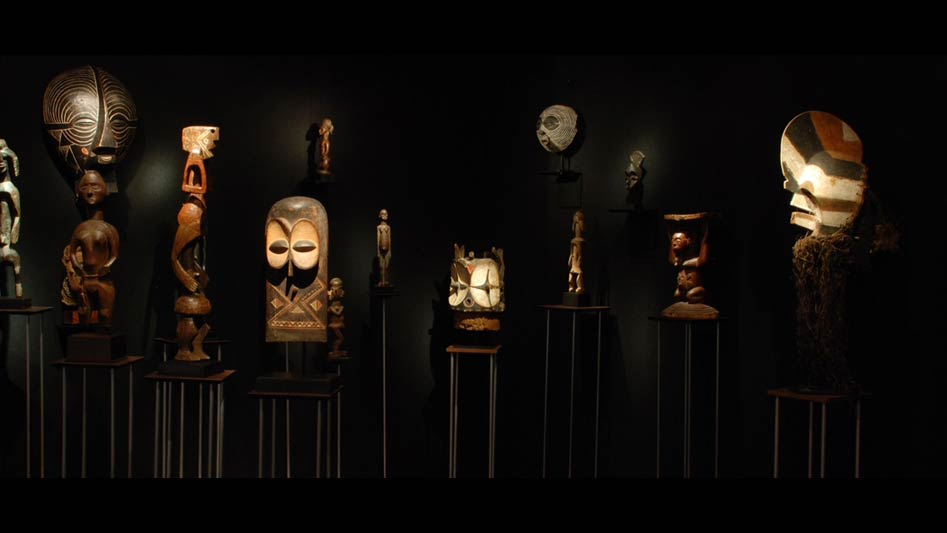
Mark Eglinton’s- New York (Photo Brian Nault)
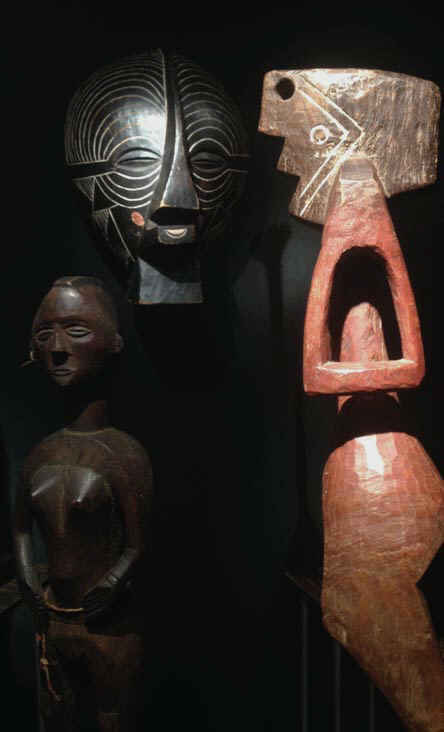
Mark was telling me that Luba mask on the wall is Ex. Willie Mestdagh. (Photo Brian Nault)
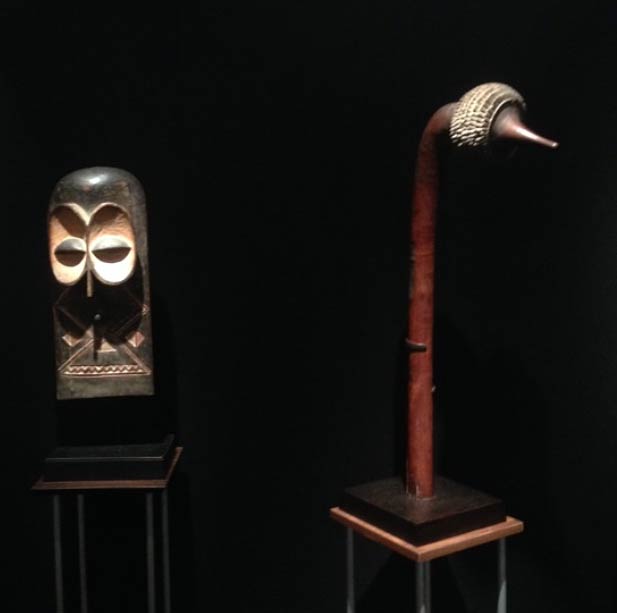
(Mark Eglinton) He sold this fine Fijian Totokia club at the show (Photo Brian Nault)
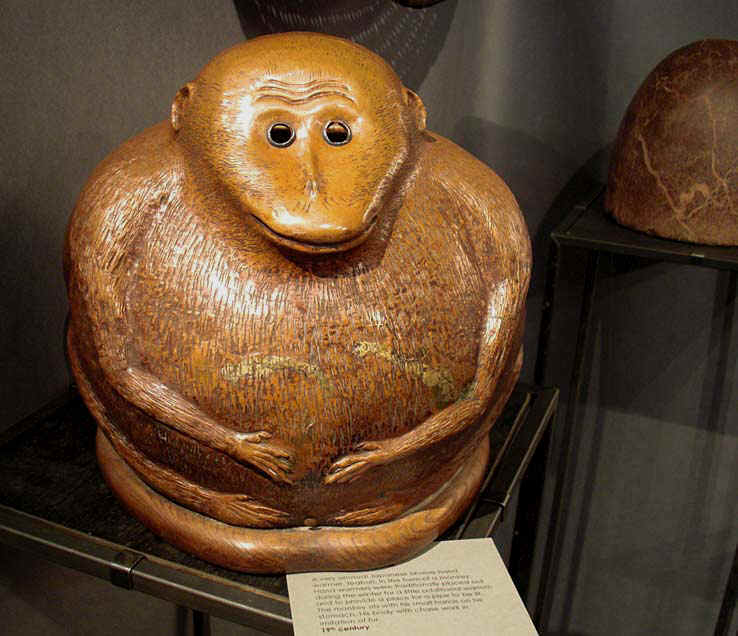
I like a good Monkey. Galen Lowe (Seattle) with a 19th c. Japanese copper monkey hand warmer.
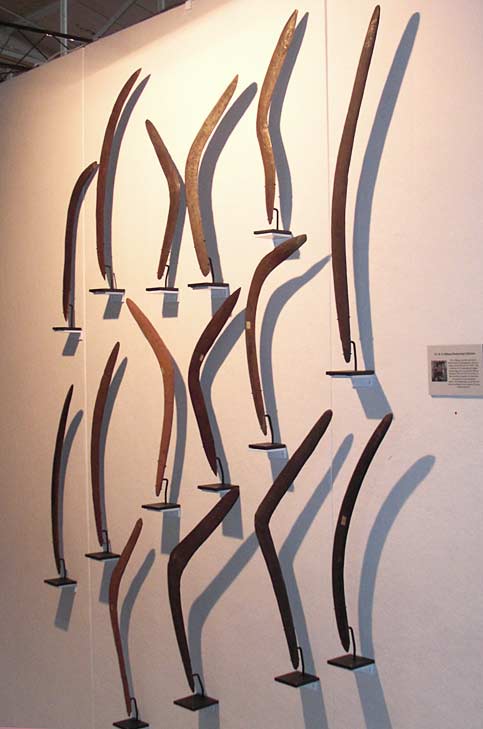
I liked Mike Hamson’s display of Boomerangs from the Oldman Collection
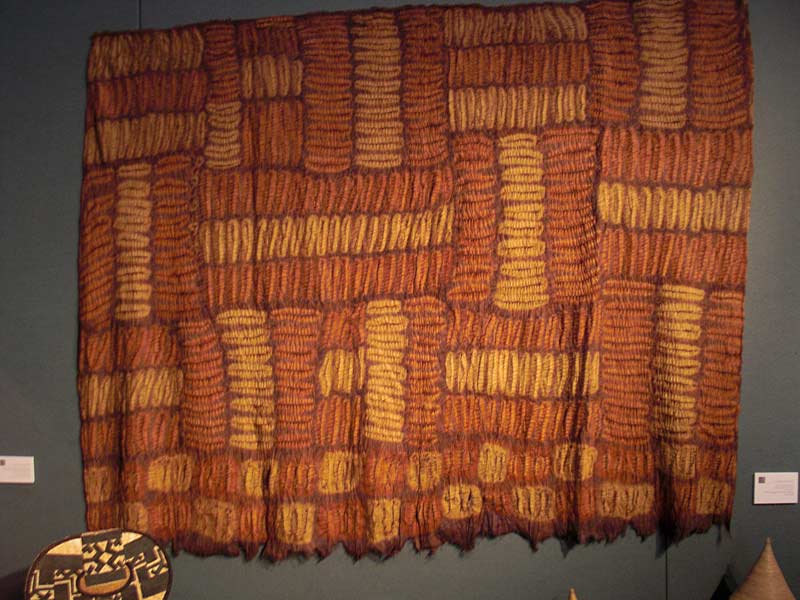
Andreas Moraga- Berkley with a handsome Dida tie died woman’s skirt from the ivory coast
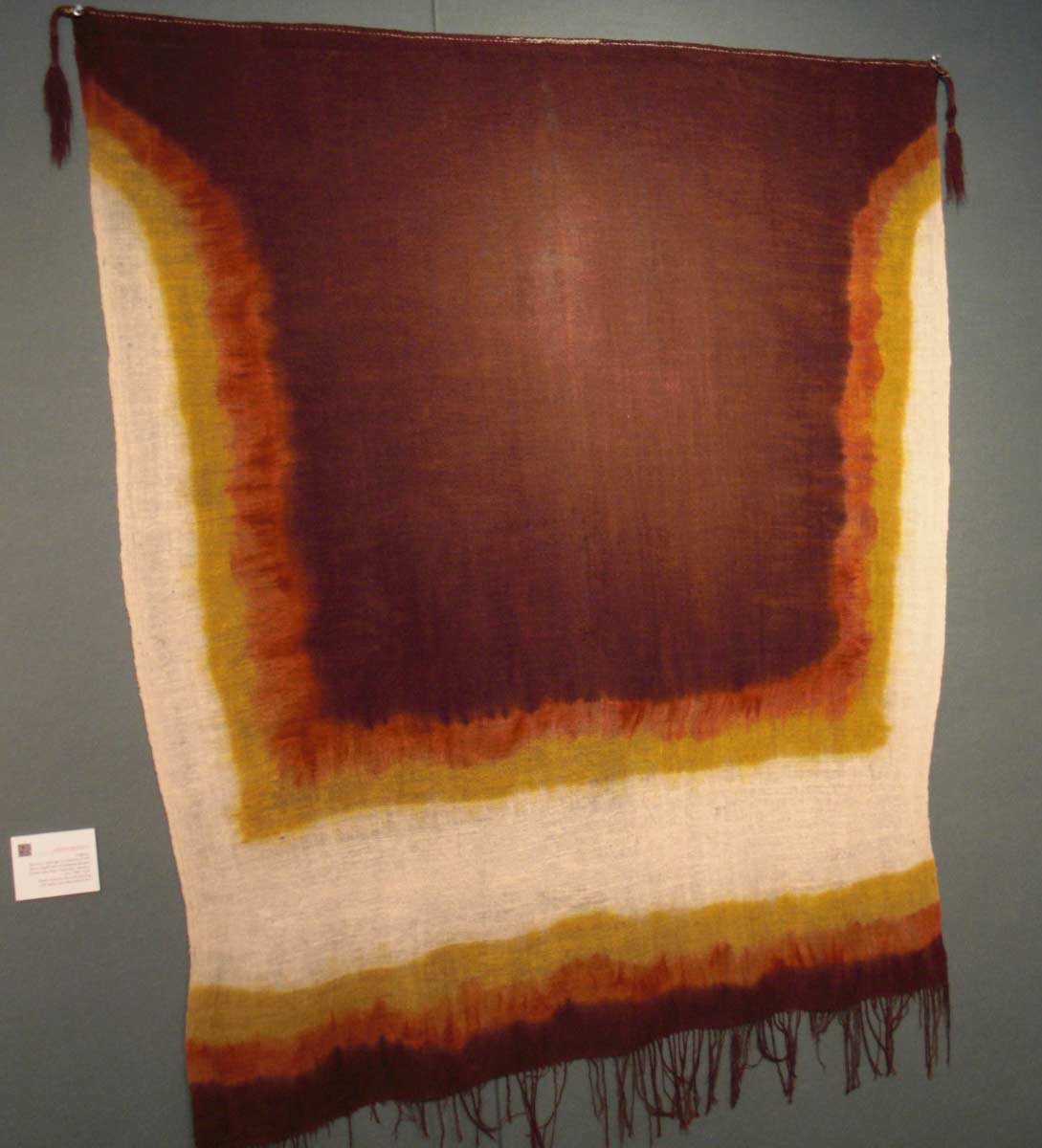
(Moraga cont.) Woman’s ceremonial veil “Tadghart” Morocco
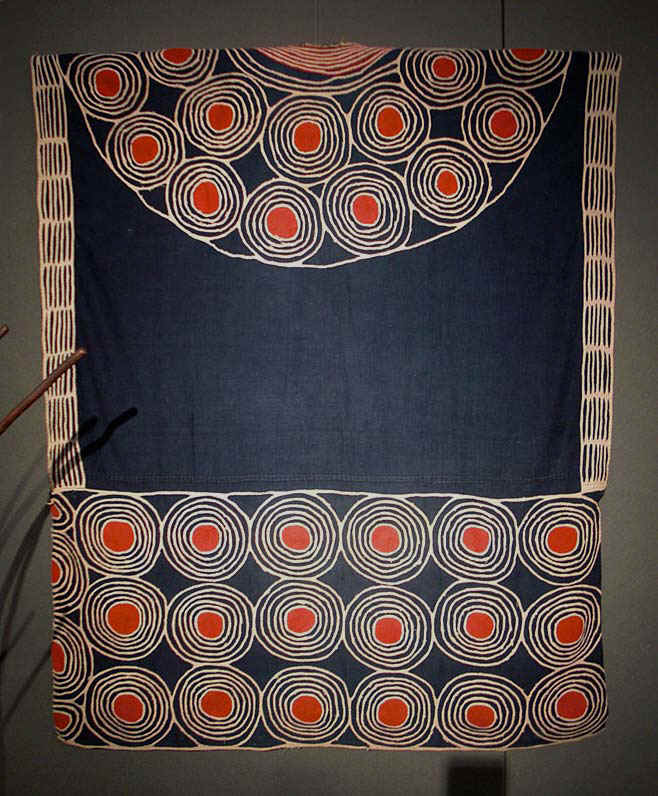
(Moraga cont.) This Cameroon Bamileke Embroidered Tunic was his catalog submission piece
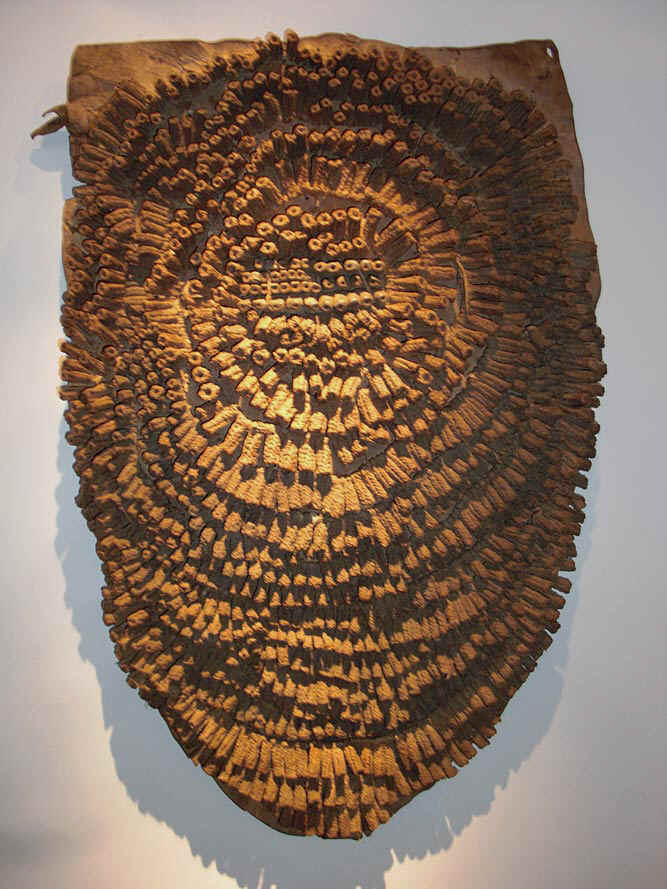
Amayas Naegele (New York) with a textural and graphic leather cape from the Turkana people of Kenya. Applied knotted fiber tubes secured with stripes of hide. The projections were probably once anchors for hundreds of ostrich plumes.
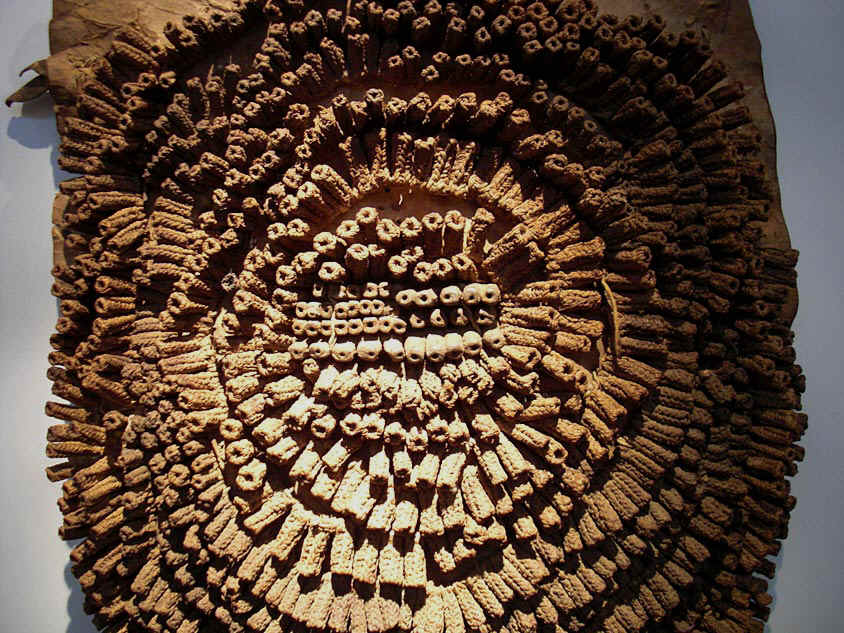
Amayas Naegele- Turkana leather cape.
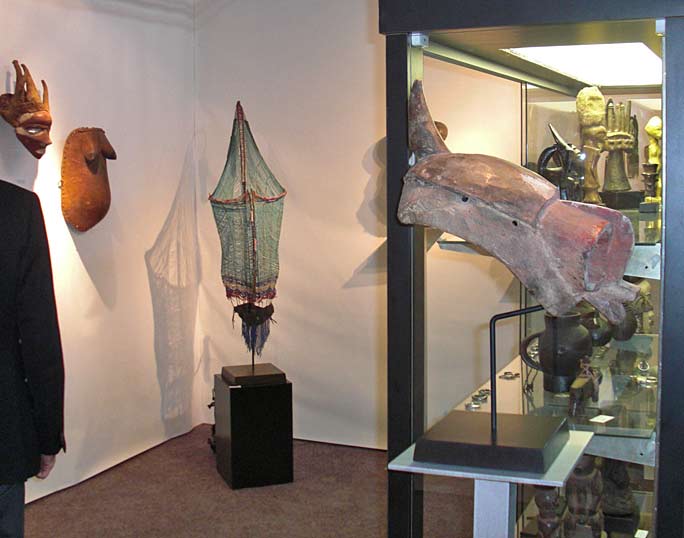
Amayas Naegele
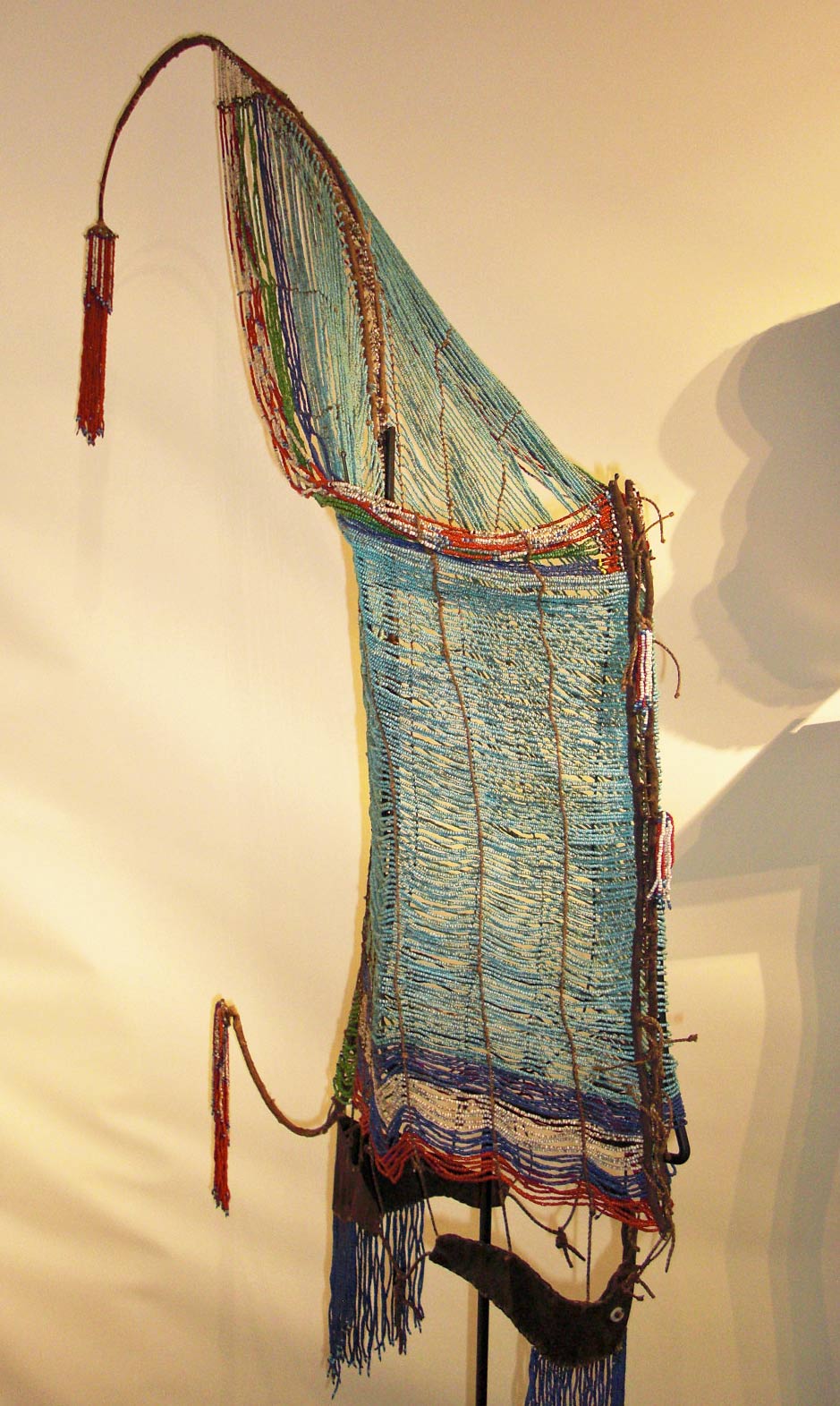
(Amayas Naegele) A flamboyant man’s beaded corset from the Dinka people of Sudan. He showed me, as a base-maker, what he had to do for the piece to keep its form. Pretty impressive.
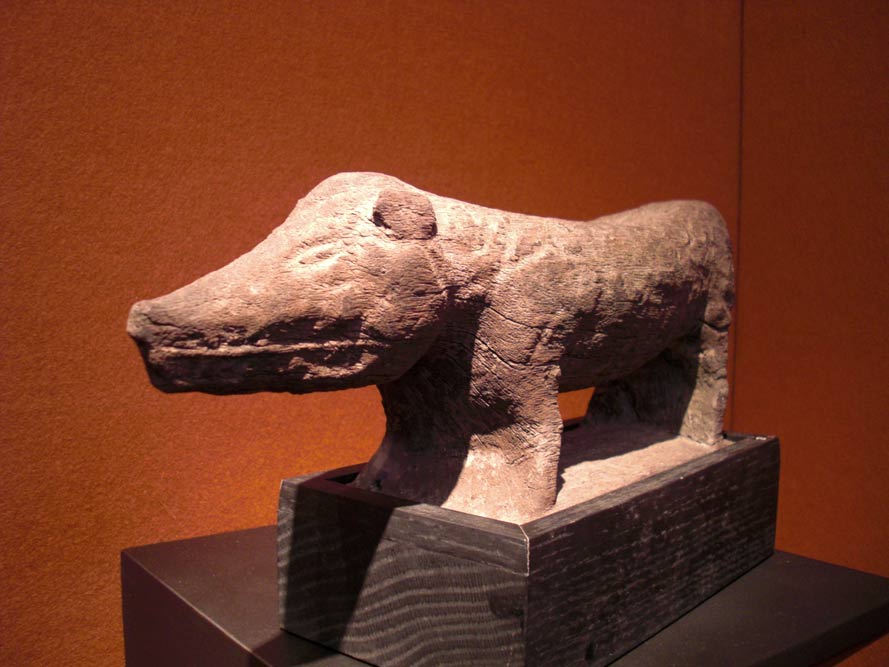
Wayne Heathcote and company. As I recall this was a New Guinea Pre-Contact neckrest from the North coast region.
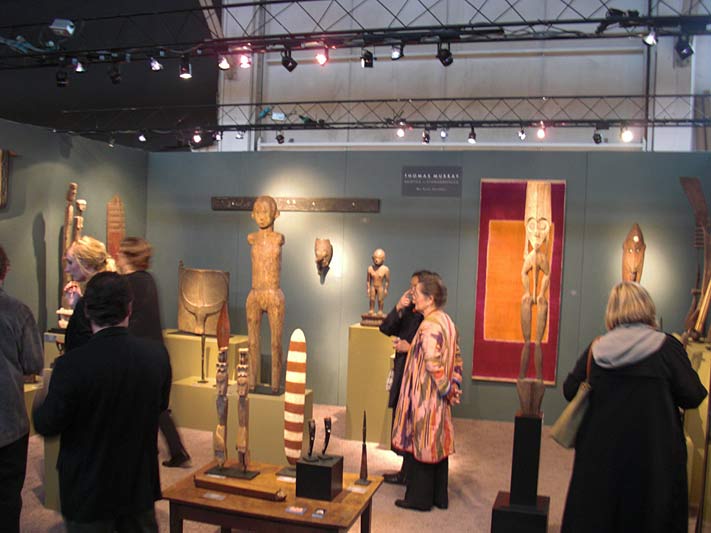
Thomas Murray- Asiatica- Ethnographica
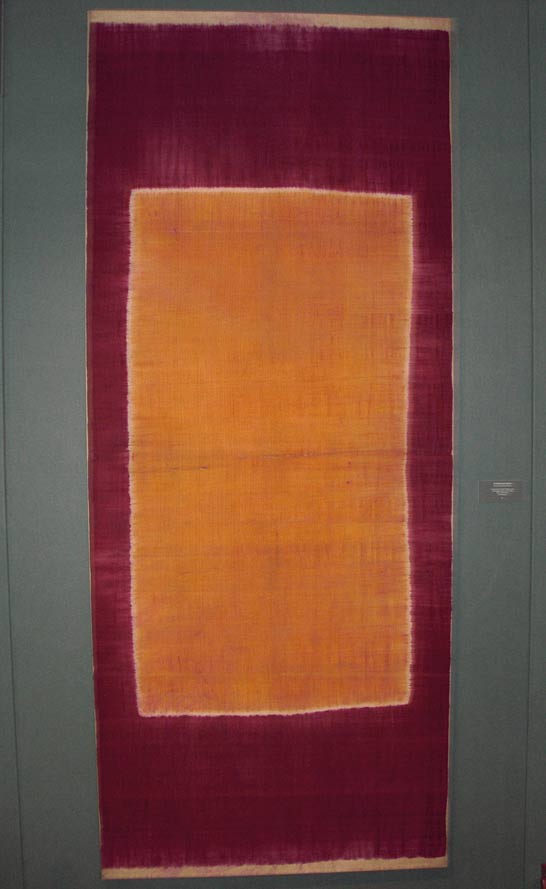
(Thomas Murray) 19th C. tie-dye Sumatra “Lawon” having an orange center and Purple border
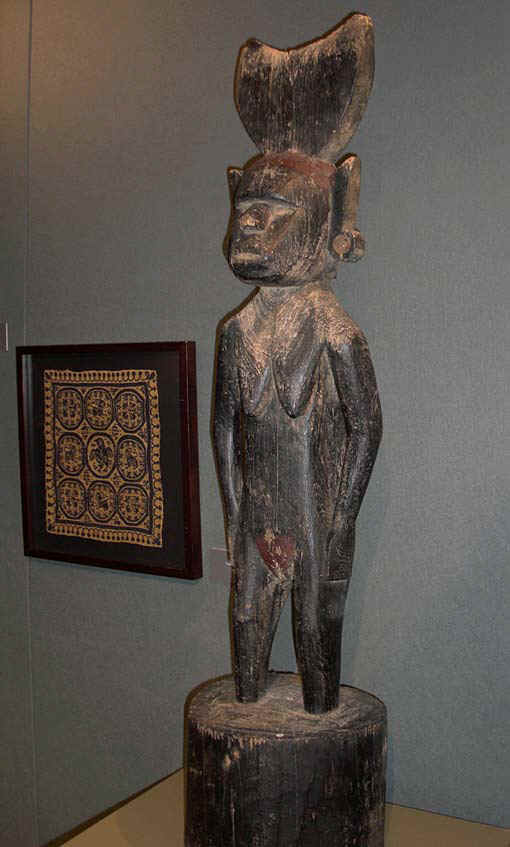
(Thomas Murray) Solomon Island female figure
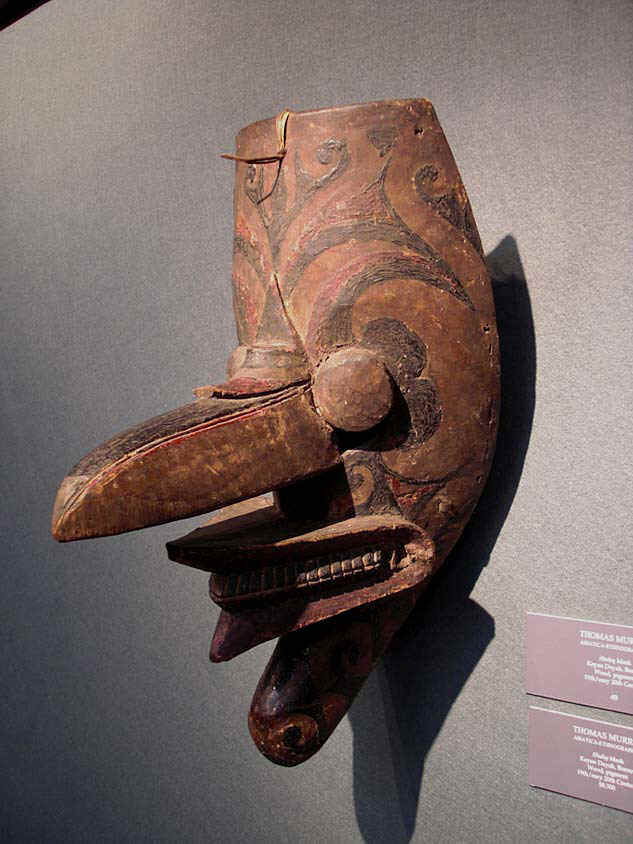
(Thomas Murray) I like the old original paint on this expressive Dayak “Hudoq” mask
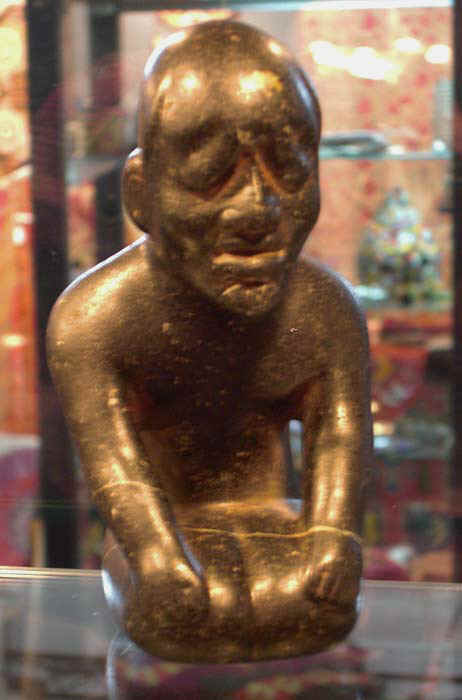
Arte Primitive- NY. Great piece but poor photo of an Olmec Shaman in a trance
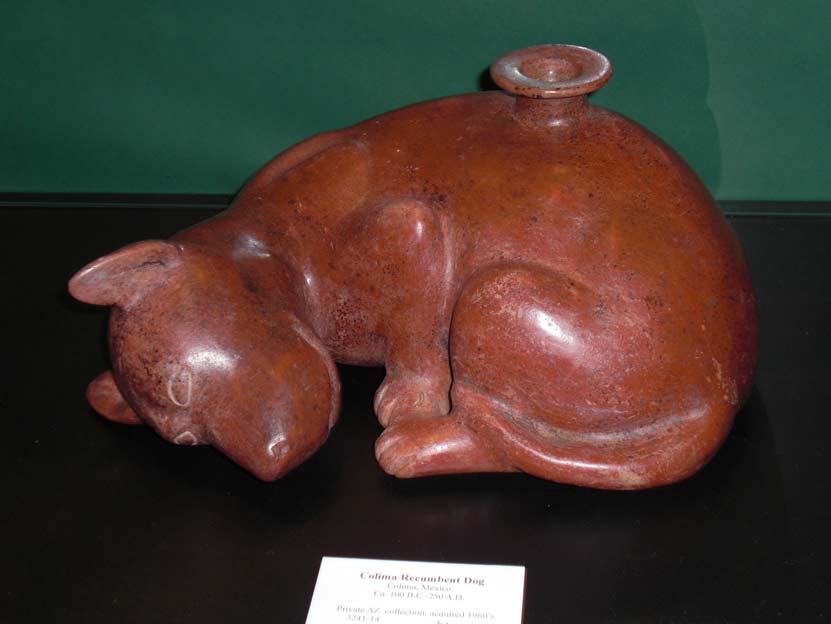
(Arte Primitive) a sleeping Colima Dog.
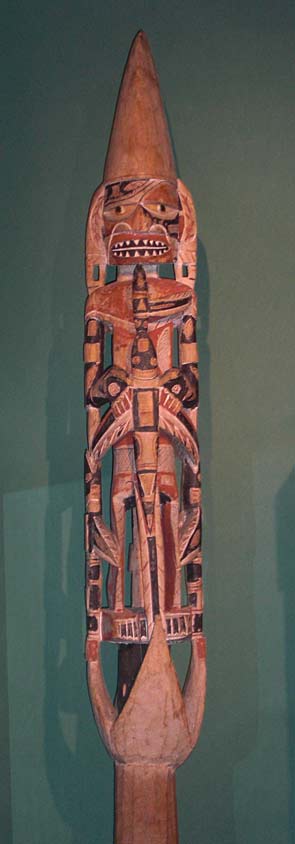
(Arte Primitive) A New Ireland Malagan Figure
Nasser Gallery- New York
(Nasser Gallery) An important early Maori head (New Zealand) with “moko” tattooing
(Nasser Gallery) 18th-19th C. Native American Woodland Indian Ballhead war club
It was good to see Jonathan Hope from the UK join the show this year. He and Rudolf Smend were exhibiting a fine quality selection of textiles.
(Mark Eglinton-NY) A Lobi figure (Photo Brian Nault)
David Zemanek- Germany, with a finely carved Yoruba Maternity kneeling bowl-barer figure
(David Zemanek) Nigerian Igbo face Mask
(David Zemanek) A 19th C. Eket Figure (Nigeria) from the Webster Collection. See inscription on back.
Neil Becker- New World Antiquities with a Northwest Coast Haida(?) Mask
(Neil Becker- New World Antiquities) An Eskimo Nunivak Island mask
(Neil Becker) A Colima Shaman Acrobat
(right to left) Neil Becker, Kip McKesson and his wife
Morgan Oakes Tribal Art- San Francisco (Callie and Sheridan Oakes) Sheridan fabricates many of the art display stands for dealers in the Bay Area.
David Cassera and Family
David Cassera- WA
Wayne Heathcote, with a very early Solomon Island kneeling female figure. Item was their catalog submission piece.
(Wayne Heathcote) A Vanuatu Ambrym Island janus staff
(Wayne Heathcote)
Wayne has not been in attendance for several years but the booth is staffed by Jack Sadovnick and Wayne’s brother Volker. They likely had the strongest sales of the fair. You’ll notice to the right of Volker (far right) is an Indonesian Tau tau figure from the Toraja people of Sulawesi. Its worth noting since there was a buzz about its fine quality. I understand it sold quickly.
(Wayne Heathcote) A Vanuatu Rambaramp effigy figure
Joel Cooner- Dallas, Looking great as always
(Joel Cooner) I liked his Songye kifwebe mask.
(Joel Cooner) A fine Naga headhunter hip ornament
Bruce Frank- NY, with a New Caledonian Kanak mask
(Bruce Frank) Nigerian Ijaw mask
(Bruce Frank) A Middle Sepik pre-contact lime stopper finial with original rattan.
(Bruce Frank) A selection of fine Dayak “tun tun” pig trap sticks from Borneo
(Bruce Frank)
(Mark Johnson) That colorful object is a Iban-Dayak ceremonial Hornbill bird effigy. It is one of the most elaborately made art types in Indonesia.
Brant Mackley- PA, with a righteous early Solomon canoe prow figurehead from Choiseul Island
Alain Naoum- Brussels
Alain Naoum- Brussels
Alain Naoum, with a Lwalwa mask
Joe Loux- San Francisco, standing next to an old Nepalese post
(Joe Loux) I like the elongated face and serene countenance
(Joe Loux) In person this Nepalese mask radiated mojo. (right) A superb Naga Hip Ornament with horns.
Art for Eternity (Howard Nowes) NY, with a Senufo Buffalo Helmet mask, Ex. Allan Stone collection
Art for Eternity (Howard Nowes) An ancient Winiama carved wood shrine figure from Burkina Faso
Ina of Insite Antiques & Design- San Francisco
Ina of Insite Antiques & Design. A Bamileke stool from Cameroon– quite a good one too!
Amyas Naegele Fine Art- NY. (Left to Right) Amyas, Professor Ray Reichert and Skip Cole (Professor Emeritus of African Art History from UCSB)
Patrick Mestdagh- Brussels. The maestro’s booth is like music notes.
Patrick Mestdagh
Patrick Mestdagh- A sweet little Marquesas Island Stilt step next to an ancient Peruvian (I think?) disk-like stone “mirror”
Patrick Mestdagh- Hawaiian bowl with repairs
Patrick Mestdagh- a paint decorated N. Philippine Shield
And ending on a happy note…. Lin Willis and Feelie Lee (Right)
END
